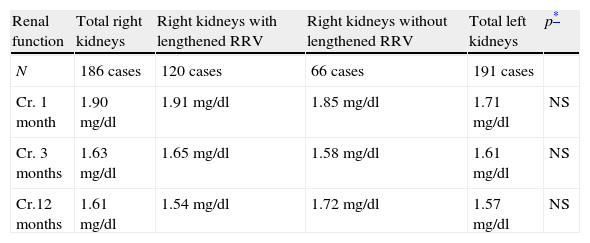Shorter length of the right renal vein (RRV) may represent an additional difficulty for transplant. This paper has aimed to present our experience with RRV elongation in the kidney from a cadaveric donor and to compare the results with the rest of kidneys transplanted in the same period of time.
Materials and methodsWe performed 377 kidneys transplants within the last 11 years. Of these, in 120, the RRV was elongated with the vena cava. The surgical technique is described and the results are compared with the remaining transplants of the series. Renal function, graft survival and complications were assessed at 1, 3 and 12 months. Data were obtained retrospectively from the database of the Urology Department and Hospital medical records.
ResultsIn the 377 transplants, there were 4 (1%) venous thrombosis, 2 (1.6%) of which concerned kidneys with elongation of the RRV and 2 (0.7%) in the rest of transplanted kidneys. There was no difference in postoperative bleeding, 11 (9.1%) occurred in kidneys with elongated RRV and 22 (8.5%) in the remaining kidney. In no case was the bleeding related to the elongated segment. Graft survival and renal function were similar for both groups.
ConclusionsElongation of the RRV with the vena cava is a feasible, fast, and effective procedure that does not increase morbidity or affect renal function or graft viability. It facilitates vascular anastomosis and places the kidney in a less forced position, shortens the warm ischemia time and avoids the risk of kinking of the renal artery because it is equal to the length of the vein artery.
La menor longitud de la vena renal derecha (VRD) puede representar una dificultad añadida para el trasplante. El objetivo de este trabajo es presentar nuestra experiencia con el alargamiento de la VRD en el riñón de donante cadáver y comparar los resultados con el resto de riñones trasplantados en el mismo período de tiempo.
Material y métodoen los últimos 11 años se realizaron 377 trasplantes renales y en 120 se alargó la VRD con la vena cava. Se describe la técnica quirúrgica y se comparan los resultados con el resto de trasplantes de la serie. Se valoró la función renal a 1, 3 y 12 meses, la supervivencia del injerto y las complicaciones. Los datos se obtuvieron de forma retrospectiva de la base de datos del Servicio de Urología y de la Historia Clínica del Hospital.
ResultadosEn los 377 trasplantes ocurrieron 4 (1%) trombosis venosas, de ellas 2 (1,6%) eran riñones con alargamiento de la VRD y 2 (0,7%) en el resto de riñones trasplantados. No hubo diferencia en el sangrado postoperatorio, 11 (9,1%) ocurrió en riñones con la VRD alargada y 22 (8,5%) en el resto de riñones. En ningún caso el sangrado estuvo relacionado con segmento alargado. La supervivencia del injerto y la función renal fue superponible en ambos grupos.
ConclusionesEl alargamiento de la VRD con la vena cava, es un procedimiento rápido, sencillo y efectivo, que no aumenta la morbilidad ni altera la función renal o la viabilidad del injerto. Facilita la realización de las anastomosis vasculares y sitúa el riñón en una posición menos forzada, acorta el tiempo de isquemia caliente y evita el riesgo de acodadura de la arteria renal ya que iguala su longitud a la de la vena.
Artículo
Comprando el artículo el PDF del mismo podrá ser descargado
Precio 19,34 €
Comprar ahora













